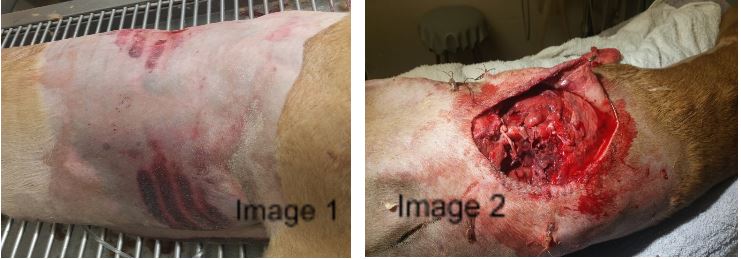Feature Cases
Read about the interesting cases that have come through our doors each month
Read about the interesting cases that have come through our doors each month
Rosie's Ovariectomy
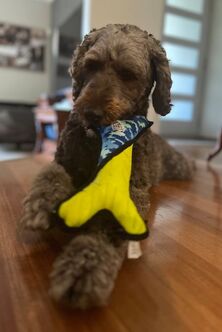
Rosie is a 4 year old Labradoodle who came to see Dr Cindy for abnormal vaginal discharge and frequent licking of her vulva. Prior to coming to us, Rosie had an ovary sparing spay (a procedure involving removal of the majority of the uterus whilst leaving one or both ovaries intact). This procedure is occasionally performed instead of the usual ovariohysterectomy (removal of the uterus and both ovaries), as it allows for continued hormone production and regular cycling without the possibility of pregnancy. Dogs that undergo ovary sparing spays, however, can have an increased risk of ovarian and mammary cancers, uterine infections, and ongoing sexual behaviours, compared to dogs that have had ovariohysterectomies.
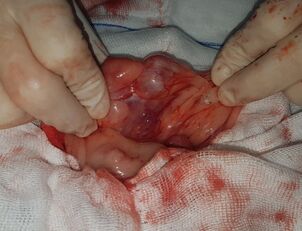
In Rosie’s case, it was suspected that her problems were due to either infection of the vagina or the remaining uterine stump, brought on by her continued hormone production. An abdominal ultrasound was performed to assess her remaining left ovary, uterine stump, and to look for any remnants of her right ovary. The ultrasound found that the left ovary had a number of large fluid-filled cysts, called a polycystic ovary.
Polycystic ovaries occur when the ovary is unable to ovulate the follicles it produces during a heat cycle. This results in signs of persistently being on heat, such as vulvar swelling, bloody or mucousy vaginal discharge, and behavioural changes. If the dog is then induced to ovulate with medication, there is a strong likelihood she will get a uterine or vaginal infection, so the preferred treatment is removal of the ovary. Dr Cindy removed Rosie’s left ovary, and sampled the vaginal discharge to determine if an infection was present.
Polycystic ovaries occur when the ovary is unable to ovulate the follicles it produces during a heat cycle. This results in signs of persistently being on heat, such as vulvar swelling, bloody or mucousy vaginal discharge, and behavioural changes. If the dog is then induced to ovulate with medication, there is a strong likelihood she will get a uterine or vaginal infection, so the preferred treatment is removal of the ovary. Dr Cindy removed Rosie’s left ovary, and sampled the vaginal discharge to determine if an infection was present.
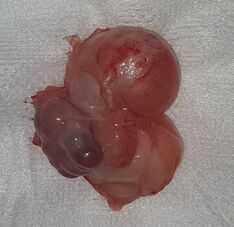
Because she had been persistently on heat, there was significant bleeding during surgery (increased blood supply to the reproductive organs), and fibrous adhesions in the abdomen due to her previous surgery. We are equipped with an electrocautery system that allowed us to efficiently stop the bleeding, and the rest of the operation went well. Results from Rosie’s vaginal swabs also showed a concurrent vaginal infection that was treated with a course of antibiotics.
Sophia And Her Nuclear Vacation
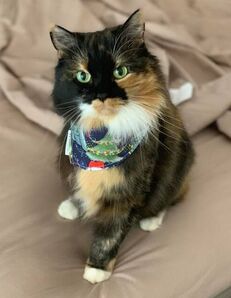
Sophia is a 15 year old domestic medium hair cat who belongs to Nurse Emma. Unfortunately, last year she was diagnosed with hyperthyroidism.
Hyperthyroidism is most common in older cats and can have a number of symptoms. Usually, it is caused by a benign growth in the thyroid known as an adenoma. This enlarged thyroid then produces excess thyroid hormones, resulting in a greatly increased metabolism and high blood pressure. In the early stages, we often see patients lose weight despite having an increased appetite. Patients can have an unkempt coat, have vomiting, diarrhoea, or become hyperactive. If left untreated, multiple organs (eg. heart, eyes) may become affected and deteriorate over time. Diagnosis can be confirmed with a blood test.
Once diagnosed, treatment can commence. Most commonly, long term twice daily medication is the treatment of choice for many patients. However, this option still carries the risk that the usually benign adenoma could develop into malignant cancer (adenocarcinoma).
Hyperthyroidism is most common in older cats and can have a number of symptoms. Usually, it is caused by a benign growth in the thyroid known as an adenoma. This enlarged thyroid then produces excess thyroid hormones, resulting in a greatly increased metabolism and high blood pressure. In the early stages, we often see patients lose weight despite having an increased appetite. Patients can have an unkempt coat, have vomiting, diarrhoea, or become hyperactive. If left untreated, multiple organs (eg. heart, eyes) may become affected and deteriorate over time. Diagnosis can be confirmed with a blood test.
Once diagnosed, treatment can commence. Most commonly, long term twice daily medication is the treatment of choice for many patients. However, this option still carries the risk that the usually benign adenoma could develop into malignant cancer (adenocarcinoma).
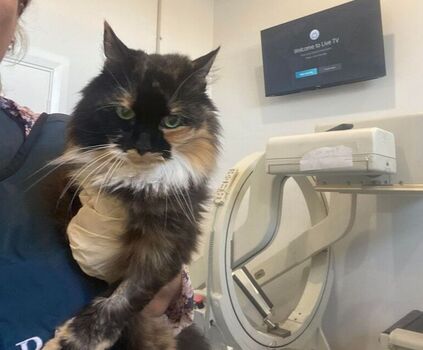
In this case, Sophia had been on medication morning and night for about 6 months with good effect. Unfortunately, many of our feline friends can be very tricky to medicate. In some cases specialised diets may be effective, however these are often not reliable, and surgery can be used for specific cases, but has the risk of significant side effects.
More recently, radioactive iodine, a treatment which can permanently cure hyperthyroidism without the need for ongoing medication, has become available for treatment in Western Australia at a small number of veterinary hospitals. Sophia was admitted to Epsom Avenue Small Animal Clinic where she had a scan to determine the size of her thyroid. After that, a specially calculated dose of radioactive iodine was injected. Iodine in the body is quickly concentrated in the thyroid gland where its radioactivity will destroy many of the functional cells. The dose is calculated such that it will destroy just enough cells to return the thyroid to normal functioning levels.
More recently, radioactive iodine, a treatment which can permanently cure hyperthyroidism without the need for ongoing medication, has become available for treatment in Western Australia at a small number of veterinary hospitals. Sophia was admitted to Epsom Avenue Small Animal Clinic where she had a scan to determine the size of her thyroid. After that, a specially calculated dose of radioactive iodine was injected. Iodine in the body is quickly concentrated in the thyroid gland where its radioactivity will destroy many of the functional cells. The dose is calculated such that it will destroy just enough cells to return the thyroid to normal functioning levels.
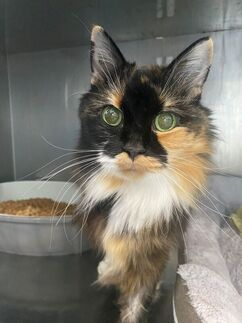
After her procedure, Sophia was required to stay in hospital for 1 week whilst radioactivity levels returned to normal, after which she was able to return home, with some extra precautionary measures for the next few weeks.
This procedure is successful in about 93% of cats. In rare instances, a small number of patients will need a second dosing. A blood test was performed 6 weeks post procedure which showed that her thyroid levels had dropped down to normal range. Another follow up blood test was then performed 6 months later, which confirmed that her thyroid is functioning at a normal level. Sophia is now free to go about her days living as a normal cat without having to deal with the stressful process of daily medications.
This procedure is successful in about 93% of cats. In rare instances, a small number of patients will need a second dosing. A blood test was performed 6 weeks post procedure which showed that her thyroid levels had dropped down to normal range. Another follow up blood test was then performed 6 months later, which confirmed that her thyroid is functioning at a normal level. Sophia is now free to go about her days living as a normal cat without having to deal with the stressful process of daily medications.
Franki and Her Injured Ear
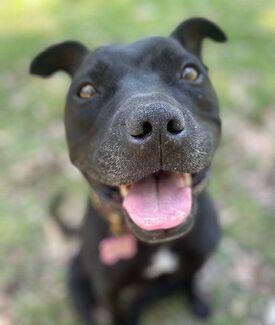
Franki is an 8 year old staffy who was bitten on the ear by another dog at the park. Franki was initially taken to her local emergency vet where a deep laceration on her left ear was cleaned and she was started on antibiotics and anti-inflammatories. At the time, it was decided that surgery would be difficult given the location of the wound, and that there was a good chance that it wouldn't be successful, so the wound was bandaged in the hope that it would heal without surgery.
There is often hidden damage present with dog fight wounds. The teeth crush the skin and underlying tissues, which can cause trauma and damage to the blood supply, leading to skin necrosis (tissue death) which may not be visible until several days after the initial incident.
There is often hidden damage present with dog fight wounds. The teeth crush the skin and underlying tissues, which can cause trauma and damage to the blood supply, leading to skin necrosis (tissue death) which may not be visible until several days after the initial incident.
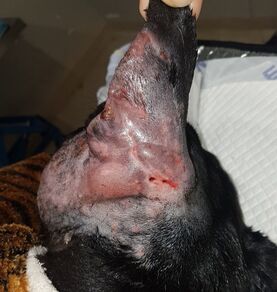
Over the coming days, Frankis ear became more swollen and infected with some parts of the ear pinna (ear flap) becoming necrotic despite being on medication. Given the state of the ear, Dr Cindy counselled Franki’s owner that amputation of the pinna may need to occur.
When preparing for surgery, the tip of the ear was tested, and Dr Cindy was able to confirm an intact blood supply which meant that the ear could likely be saved. One potential drawback to surgical repair of the ear however, is that the edges of the repaired tissue may contract, deforming the ear pinna, but this is still generally preferable to amputation.
When preparing for surgery, the tip of the ear was tested, and Dr Cindy was able to confirm an intact blood supply which meant that the ear could likely be saved. One potential drawback to surgical repair of the ear however, is that the edges of the repaired tissue may contract, deforming the ear pinna, but this is still generally preferable to amputation.
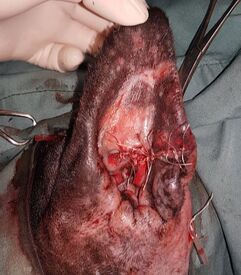
During surgery, large amounts of infected material and pus were cleaned away, necrotic tissue surgically removed, and a sample was sent to an external laboratory to culture the bacteria. The ear pinna was sutured back together.
2 weeks later, she had healed with minimal deformity to the ear.
2 weeks later, she had healed with minimal deformity to the ear.
Ollie's Park Trip
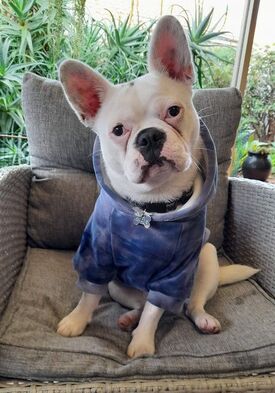
Ollie is a 1yr old French Bulldog X Pug who presented to us recently as he suddenly became very unwell, wobbly on his feet and hyper-reactive to noises following a visit to the park. On examination, Ollie seemed very disoriented and was constantly swaying and unable to maintain balance. His pupils were miotic (constricted) and did not respond appropriately to light. His body temperature was also very low.
Ollie was admitted into hospital for further investigation and supportive care. He was started on intravenous fluid therapy in case of possible toxin exposure, as fluids can help flush the toxins out of the system quicker. Additionally, bloodwork was performed, which showed mild inflammatory changes. There were concerns that Ollie may have accidentally ingested a toxin or recreational drug, and so drug tests were performed on his urine as well. Marijuana was detected in Ollie’s urine, and this was likely responsible for the clinical signs seen.
Marijuana intoxication can occur in any dog that accidentally ingests the substance, and symptoms typically begin 30-90mins following consumption. The typical signs include incoordination, slow heart rate, altered pupil size (usually dilated), sedation and occasionally urinary incontinence. In severe cases, vomiting, seizures, and heightened sensitivity to noise and/or light can occur.
Ollie was admitted into hospital for further investigation and supportive care. He was started on intravenous fluid therapy in case of possible toxin exposure, as fluids can help flush the toxins out of the system quicker. Additionally, bloodwork was performed, which showed mild inflammatory changes. There were concerns that Ollie may have accidentally ingested a toxin or recreational drug, and so drug tests were performed on his urine as well. Marijuana was detected in Ollie’s urine, and this was likely responsible for the clinical signs seen.
Marijuana intoxication can occur in any dog that accidentally ingests the substance, and symptoms typically begin 30-90mins following consumption. The typical signs include incoordination, slow heart rate, altered pupil size (usually dilated), sedation and occasionally urinary incontinence. In severe cases, vomiting, seizures, and heightened sensitivity to noise and/or light can occur.
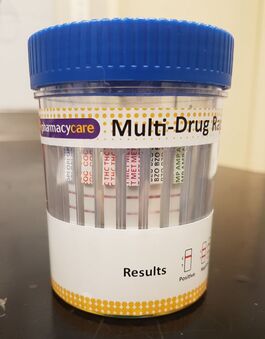
For Ollie, he was administered activated charcoal, which is commonly used in the treatment of poisonings. Activated charcoal is given orally and binds to toxins as it passes through the body. Additionally, Ollie was given a dose of Naloxone intravenously. Naloxone is a medication used to reverse the effects of opioid drugs, but has been reported to be successful in the treatment of cannabis overdose.
Ollie was monitored closely in hospital, and began to show significant improvement as the day went on. Just several hours following his initial presentation, Ollie was able to walk normally again with his tail wagging, and was no longer hyper-reactive to noises. He was able to be reunited with his family that evening.
Ollie was very fortunate that his owners picked up that something was wrong early, and brought him in to see us so that supportive treatment could be started. Whilst the chances of fatality through marajuana overdose is small, it is still possible in our companion animals. We contacted Ollie’s owners the next day to check in on him, and we were happy to hear that Ollie was back to his usual crazy self!
Ollie was monitored closely in hospital, and began to show significant improvement as the day went on. Just several hours following his initial presentation, Ollie was able to walk normally again with his tail wagging, and was no longer hyper-reactive to noises. He was able to be reunited with his family that evening.
Ollie was very fortunate that his owners picked up that something was wrong early, and brought him in to see us so that supportive treatment could be started. Whilst the chances of fatality through marajuana overdose is small, it is still possible in our companion animals. We contacted Ollie’s owners the next day to check in on him, and we were happy to hear that Ollie was back to his usual crazy self!
Bruiser And His Treacherous Treat
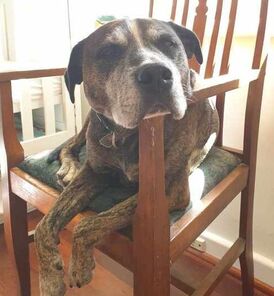
Bruiser is a 7 year old Staffy cross who came to us recently after an ill fated snack. Bruiser managed to get a hold of a silicone cupcake mould containing half of a cupcake which he promptly swallowed whole before his people could stop him.
Plastic or rubber food packaging which still contains remnants of food are often targeted by our canine friends as they have the same aroma and taste as the food they contained, and dogs will sometimes swallow the packaging whole before they are able to be stopped. Meat skewers (with or without meat attached) are also occasional targets for the same reason.
Plastic or rubber food packaging which still contains remnants of food are often targeted by our canine friends as they have the same aroma and taste as the food they contained, and dogs will sometimes swallow the packaging whole before they are able to be stopped. Meat skewers (with or without meat attached) are also occasional targets for the same reason.
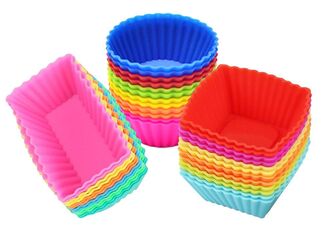
Whilst the dangers of swallowing a skewer whole are obvious, the dangers associated with swallowing soft plastic or silicone may be less apparent. The digestive tract is unable to break these products down, and once in the stomach, the only way to go is forward, through the narrow intestines. This will often lead to blockages in the gastrointestinal tract, preventing food and other digestive material from passing through causing severe vomiting.
More critically, pressure caused by the blockage can prevent blood flow to a portion of the intestine, which will result in tissue death and ultimately leading to break-down of the intestines, causing the abdomen to become septic. Without immediate treatment, this will result in death.
More critically, pressure caused by the blockage can prevent blood flow to a portion of the intestine, which will result in tissue death and ultimately leading to break-down of the intestines, causing the abdomen to become septic. Without immediate treatment, this will result in death.
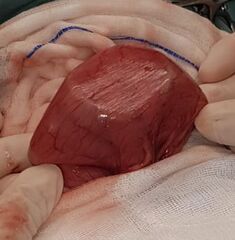
Because of this danger, it is imperative to remove the material before it can move into the intestine and cause a blockage. There are several ways to achieve this.
Method 1 is to make the patient vomit up the material. This is the least invasive method and can often be an easy way to solve the issue, as long as there's no risk of the material causing damage on the way up. It does have its limitations however. In this case, Bruiser was given apomorphine, a medication which rapidly causes a short duration of significant vomiting. Unfortunately, all he was able to bring up was some foamy liquid as the silicone cupcake mould was blocking the outlet of his stomach.
Method 1 is to make the patient vomit up the material. This is the least invasive method and can often be an easy way to solve the issue, as long as there's no risk of the material causing damage on the way up. It does have its limitations however. In this case, Bruiser was given apomorphine, a medication which rapidly causes a short duration of significant vomiting. Unfortunately, all he was able to bring up was some foamy liquid as the silicone cupcake mould was blocking the outlet of his stomach.
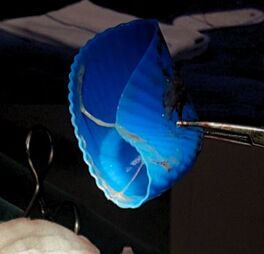
Method 2 involves a general anaesthetic to feed a scope, fitted with a small grabbing claw, down the oesophagus. Unfortunately in this case, the slippery nature of the silicone, coupled with the rounded edges made it impossible to properly grip the mould for extraction.
Method 3 is to surgically open up the stomach to manually remove the foreign object. This is the most invasive method, however in many cases it is the only viable option. Bruiser went into surgery that same day. A large incision was made into his abdomen and then an incision was made into his stomach, where the silicone mould was removed.
Method 3 is to surgically open up the stomach to manually remove the foreign object. This is the most invasive method, however in many cases it is the only viable option. Bruiser went into surgery that same day. A large incision was made into his abdomen and then an incision was made into his stomach, where the silicone mould was removed.
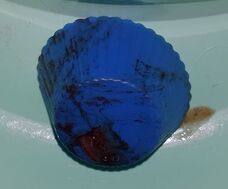
Following his surgery, Bruiser was a bit groggy for a few days, but soon recovered and was back to his usual self.
Bruiser's people would like to share his story to hopefully prevent this from happening to another unsuspecting pooch.
Bruiser's people would like to share his story to hopefully prevent this from happening to another unsuspecting pooch.
Apollo’s Dangerous Snack
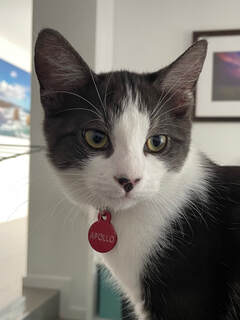
Apollo, a 9.5m old kitten, presented to KSAH because he had been off food for a few days. His owners had seen him chew and possibly swallow a piece of ribbon or elastic from a toy before he became unwell.
Apollo was repeatedly uncomfortable (hissing and trying to bite) when we palpated the front half of his abdomen. Due to his abdominal pain and history of potentially ingesting something he shouldn’t have, his owners decided to proceed with abdominal ultrasound the following day.
The ultrasound scan showed that Apollo had a foreign object in his stomach. A type of endoscopy called gastroscopy was performed under general anaesthetic to try to retrieve the foreign object from his stomach. A gastroscope involves passing a camera down the oesophagus into the stomach to visually assess what is present and if appropriate, pass a pair of forceps down the endoscope tubing to try to grab the object. This means that surgery can be avoided.
Apollo was repeatedly uncomfortable (hissing and trying to bite) when we palpated the front half of his abdomen. Due to his abdominal pain and history of potentially ingesting something he shouldn’t have, his owners decided to proceed with abdominal ultrasound the following day.
The ultrasound scan showed that Apollo had a foreign object in his stomach. A type of endoscopy called gastroscopy was performed under general anaesthetic to try to retrieve the foreign object from his stomach. A gastroscope involves passing a camera down the oesophagus into the stomach to visually assess what is present and if appropriate, pass a pair of forceps down the endoscope tubing to try to grab the object. This means that surgery can be avoided.
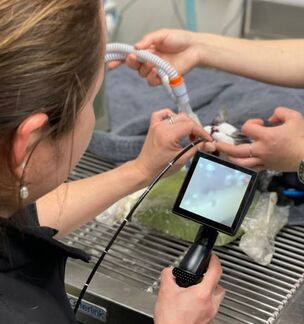
Dr Cindy commenced the gastroscopy with assistance from our nursing team and upon entering the stomach, identified a rubber band floating freely in his stomach! The foreign body forceps were passed through the endoscope and a broken elastic band was successfully removed from the stomach. The endoscope was advanced back into the stomach to ensure there were no other objects present.
After waking up from anaesthetic Apollo’s stomach was much more comfortable and he had a very good appetite that evening once he got home. He continued to recover uneventfully over the following days and was back to his mischievous self in no time.
After waking up from anaesthetic Apollo’s stomach was much more comfortable and he had a very good appetite that evening once he got home. He continued to recover uneventfully over the following days and was back to his mischievous self in no time.
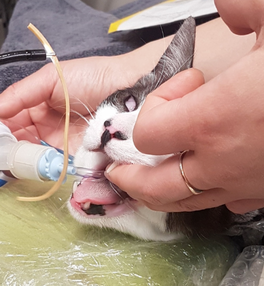
Any foreign object can cause an obstruction (blockage) of the stomach or intestines depending on the size of the object/patient (that then requires surgical removal), but string-like items such as elastic bands, string, fabric and rope can cause severe intestinal damage (e.g. perforation) that can result in lengths of intestine being removed.
It is important that if you ever notice your animal eating something they are not supposed to, that you contact your veterinary team for advice and treatment as soon as possible.
It is important that if you ever notice your animal eating something they are not supposed to, that you contact your veterinary team for advice and treatment as soon as possible.
Ben's Year Long Macadamia Journey
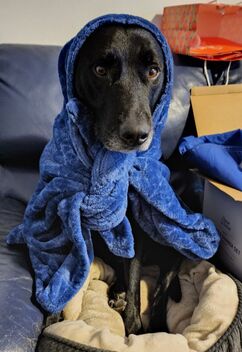
Ben is a 7 year old kelpie cross who was presented to KSAH for vomiting. He had been at an emergency clinic the night before and was not improving, so his owners brought him in for further investigation.
He was flat and lethargic and had vomited up bloody fluid. 12 months ago Ben had managed to raid a bowl of macadamia nuts (some of which were still in their shells) and since then has been occasionally vomiting up pieces of indigestible macadamia shells. We were concerned that one of these nuts had become lodged in his intestines and caused a serious obstruction.
Ben was admitted for abdominal ultrasound which identified that there was a 2.5cm round foreign object in his jejunum (middle part of his small intestine) and that the surrounding tissues were very inflamed. Dr Cindy then proceeded to surgery with Ben as it was very unlikely that the macadamia nut would pass on its own and there was a risk that his intestines would rupture if the object was left in place.
He was flat and lethargic and had vomited up bloody fluid. 12 months ago Ben had managed to raid a bowl of macadamia nuts (some of which were still in their shells) and since then has been occasionally vomiting up pieces of indigestible macadamia shells. We were concerned that one of these nuts had become lodged in his intestines and caused a serious obstruction.
Ben was admitted for abdominal ultrasound which identified that there was a 2.5cm round foreign object in his jejunum (middle part of his small intestine) and that the surrounding tissues were very inflamed. Dr Cindy then proceeded to surgery with Ben as it was very unlikely that the macadamia nut would pass on its own and there was a risk that his intestines would rupture if the object was left in place.
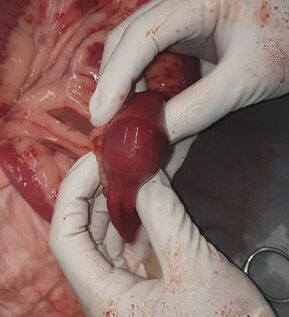
During surgery, an 8cm section of intestine behind the foreign body was very dark (should normally be a healthy pink) and it had likely died due to poor blood flow. An incision was made over the foreign body exposing an intact macadamia nut and an additional partial shell.
Due to the severely diseased section of intestine and poor intestinal contractions on either side of this area (indicating that the intestines had been badly damaged despite looking healthy), a total of 28.5cm of Ben’s intestine had to be removed. A procedure called an end-to-end anastomosis was performed to reattach the two ends of his intestine back together after the unhealthy portion had been removed.
Due to the severely diseased section of intestine and poor intestinal contractions on either side of this area (indicating that the intestines had been badly damaged despite looking healthy), a total of 28.5cm of Ben’s intestine had to be removed. A procedure called an end-to-end anastomosis was performed to reattach the two ends of his intestine back together after the unhealthy portion had been removed.
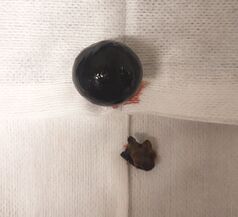
Ben was discharged the following day after spending the night at emergency for supportive care and was monitored closely at home by his family for any complications.
Ben steadily improved over the days to come and is now back to his bright and happy self (and hopefully not snacking on inappropriate things).
Ben steadily improved over the days to come and is now back to his bright and happy self (and hopefully not snacking on inappropriate things).
Brodey's Tongue Tied

Brodey is a 2 year old Jack Russell Terrier X who presented to us for gagging whenever he tried to eat. Despite some anti-inflammatory medication to treat a suspected throat irritation, Brodey continued gagging intermittently.
Dr Sam anaesthetised Brodey to examine his throat in further detail. He noticed a small white thread was looped around the base of Brodey’s tongue, and it continued down into the oesophagus.
Dr Sam anaesthetised Brodey to examine his throat in further detail. He noticed a small white thread was looped around the base of Brodey’s tongue, and it continued down into the oesophagus.

The thread had caused significant trauma to the underside of the tongue.
When it was pulled from the oesophagus, it was discovered that a large amount of hair, fur and foreign material was attached to the end of the thread.
When it was pulled from the oesophagus, it was discovered that a large amount of hair, fur and foreign material was attached to the end of the thread.

The laceration to the tongue was surgically debrided (surgical removal of necrotic tissue) and repaired, and Brodey was sent home with a course of pain relief and antibiotics.
He has since made a good recovery, and the gagging has completely resolved after this procedure.
He has since made a good recovery, and the gagging has completely resolved after this procedure.
Bridget and Her Sore Eye

Bridget, a 12 year old Beagle, came to us with a weepy right eye.
Dr Cindy could see a 2mm foreign object in the right eye. The sclera of the eye (the dense, white, fibrous membrane that forms part of the external covering of the eye) was very inflamed and irritated. It was recommended that the foreign material be removed under general anaesthetic, and Bridget’s dedicated owners went ahead with the procedure the very next day.
Prior to anaesthetising Bridget, her intraocular pressures (the pressure within the eyeballs) were measured to ensure that they were within normal limits. Dr Jess then proceeded to remove the foreign object from Bridget’s right eye.
Dr Cindy could see a 2mm foreign object in the right eye. The sclera of the eye (the dense, white, fibrous membrane that forms part of the external covering of the eye) was very inflamed and irritated. It was recommended that the foreign material be removed under general anaesthetic, and Bridget’s dedicated owners went ahead with the procedure the very next day.
Prior to anaesthetising Bridget, her intraocular pressures (the pressure within the eyeballs) were measured to ensure that they were within normal limits. Dr Jess then proceeded to remove the foreign object from Bridget’s right eye.

This was done via applying very gentle pressure and hooking out the foreign material with the tip of a very fine needle. A lot of care had to be taken to not inadvertently cause more damage to the eye. An approximately 1.5mm wide x 1mm deep defect to the cornea was left behind from the offending object, which healed without issues via a course of antibacterial eye drops and pain relief post operatively.
It is important to remember that because eyes are such fragile yet important structures to the body, if you ever notice that your pet’s eyes just ‘don’t seem quite right’, do give us a call for a chat and further advice.
It is important to remember that because eyes are such fragile yet important structures to the body, if you ever notice that your pet’s eyes just ‘don’t seem quite right’, do give us a call for a chat and further advice.
Ginger's Leg Troubles

Ginger, a Chihuahua cross, presented to KSAH at 11 months of age as she wasn't using her left hind leg after jumping into the air after her ball. She was very painful on palpation of her left hind leg. Xrays showed that Ginger had a fracture to her tibial tuberosity.
The tibial tuberosity is the front of her shin bone and is shown in the xrays on the right hand side. This is a fracture that can occur in young growing dogs as the tibial tuberosity has a separate growth plate to the top of the tibial bone.
The tibial tuberosity is the front of her shin bone and is shown in the xrays on the right hand side. This is a fracture that can occur in young growing dogs as the tibial tuberosity has a separate growth plate to the top of the tibial bone.

This fracture was repaired by Dr Ewen Blaikie who is a visiting surgeon who performs our advanced orthopaedic surgeries. The fractured piece of bone was secured back to the front of the tibia with two metal pins to allow the bone to heal back together.
Ginger stayed in hospital overnight on a strong pain relief drip and was sent home the next day with several pain relief medications to keep her comfortable. Her leg was bandaged for two weeks following surgery and she was strictly cage rested for the same duration, before slowly increasing her activity levels at home.
Ginger stayed in hospital overnight on a strong pain relief drip and was sent home the next day with several pain relief medications to keep her comfortable. Her leg was bandaged for two weeks following surgery and she was strictly cage rested for the same duration, before slowly increasing her activity levels at home.

6 weeks after surgery, xrays confirmed that she had healed well. We later saw her back for her first yearly vaccination at which she was using her left hind leg very well as though she had never had any issues to begin with.
Miley's Growing Pains
Miley was only a 4 month old miniature dachshund puppy when she visited us for the first time as she was not bearing weight on her left forelimb.
Miley’s x-rays showed that she had sustained a Salter Harris type 5 fracture to her ulna (one of her forelimb bones). Salter Harris fractures are fractures involving the growth plate of a bone, and can be classified as types 1 (I) to 5 (V) as shown below.
Miley’s x-rays showed that she had sustained a Salter Harris type 5 fracture to her ulna (one of her forelimb bones). Salter Harris fractures are fractures involving the growth plate of a bone, and can be classified as types 1 (I) to 5 (V) as shown below.
- Type I: fracture passes all the way through the growth plate.
- Type II: fracture passes through most of the growth plate and up into the portion of bone above.
- Type III: fracture passes through the growth plate and down into the portion of bone below.
- Type IV: fracture that passes through the bone above, through the growth plate and below.
- Type V: fracture that crushes the growth plate.
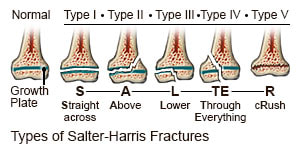
Damage to growth plates before natural closure may hinder further bone development and growth in puppies. In Miley’s case, if her radius bone kept growing while her ulna had stopped, her forelimb may develop a valgus limb deformity (outward angulation of the limb).
Miley’s leg was splinted and bandaged to provide support, and she required weekly rechecks and bandage changes every second week, with repeat x-rays along the way. Her very dedicated owner was also given the difficult task of keeping her activity restricted.
Miley’s leg was splinted and bandaged to provide support, and she required weekly rechecks and bandage changes every second week, with repeat x-rays along the way. Her very dedicated owner was also given the difficult task of keeping her activity restricted.
One month after Miley’s injury, she was doing very well, but her limb was showing abnormal angulation. Dr Cindy performed an ulnar ostectomy; a surgical procedure where a portion of the ulna is removed. This allowed the radius to continue growing correctly without restraint from a shortened ulna, thus avoiding bowing of the leg.
Further x-rays taken another 1 month post op showed good healing and no further progression of the angular limb deformity. With that, Miley was given the okay to slowly have her activity allowances increased again.
It was a long journey for Miley, but both her and her owner did a wonderful job during those few months!
Further x-rays taken another 1 month post op showed good healing and no further progression of the angular limb deformity. With that, Miley was given the okay to slowly have her activity allowances increased again.
It was a long journey for Miley, but both her and her owner did a wonderful job during those few months!
Ralph's Ouchy Teeth

Ralph is a 6 year old Maltese X that visited us for a routine periodontal treatment. He had significant tartar accumulation on his teeth but was otherwise well.
Dr Jess performed a detailed examination of Ralph’s oral cavity under anaesthesia. She discovered a deep defect in his lower right 4th premolar (on the tongue-facing surface of the tooth).
Dr Jess performed a detailed examination of Ralph’s oral cavity under anaesthesia. She discovered a deep defect in his lower right 4th premolar (on the tongue-facing surface of the tooth).
This defect communicated with the tooth’s pulp cavity (the central chamber in a tooth containing sensitive nerve roots and blood vessels). Dental radiographs showed resorption of the roots affecting both the 4th premolars in the lower jaw.
Resorptive lesions, whilst fairly common in cats, occur infrequently in dogs, and can affect any tooth. The cause is generally unknown. This disease process is caused by the animal’s own cells (called odontoclasts) destroying the tooth from underneath the enamel. Affected teeth are very sensitive, and if the nerve is exposed they can be intensely painful.
Affected animals can show signs of pain (e.g. drooling, bleeding, pawing at their face, difficulty chewing) or may hide their pain extremely well (just like Ralph) causing their pet parents to be none-the-wiser. The only treatment for resorbed teeth is surgical extraction.
Resorptive lesions, whilst fairly common in cats, occur infrequently in dogs, and can affect any tooth. The cause is generally unknown. This disease process is caused by the animal’s own cells (called odontoclasts) destroying the tooth from underneath the enamel. Affected teeth are very sensitive, and if the nerve is exposed they can be intensely painful.
Affected animals can show signs of pain (e.g. drooling, bleeding, pawing at their face, difficulty chewing) or may hide their pain extremely well (just like Ralph) causing their pet parents to be none-the-wiser. The only treatment for resorbed teeth is surgical extraction.

Dr. Jess performed surgical extraction of both of Ralph’s lower jaw 4th premolars, which was an extensive and complicated procedure (due to the teeth having multiple roots). A local nerve block was injected into each jaw to numb the surgery sites. This provides a higher level of pain relief for Ralph.
The oral surgery involved the creation of gum flaps, high speed burring (to section the teeth into single roots to aid removal) and gentle elevation of the tooth roots. Post-operative x-rays were taken to confirm complete removal of the affected teeth. The gum flaps were then sutured back together to close the defect left behind by the extracted teeth.
Ralph was provided with take-home strong pain relief and antibiotics to aid recovery. He went home a happy boy.
His case showed that even if a tooth looks normal externally, disease can still exist below the gumline, emphasising the importance of intraoral dental radiographs in detecting painful dental conditions.
The oral surgery involved the creation of gum flaps, high speed burring (to section the teeth into single roots to aid removal) and gentle elevation of the tooth roots. Post-operative x-rays were taken to confirm complete removal of the affected teeth. The gum flaps were then sutured back together to close the defect left behind by the extracted teeth.
Ralph was provided with take-home strong pain relief and antibiotics to aid recovery. He went home a happy boy.
His case showed that even if a tooth looks normal externally, disease can still exist below the gumline, emphasising the importance of intraoral dental radiographs in detecting painful dental conditions.
Brucey and His Twig

Brucey is a 3 year old Jack Russell x Chihuahua cross that was rushed to KSAH after having a bout of sudden onset severe sneezing while at the park. He had also sprayed some blood droplets in the midst of his sneezing fit.

Dr Cindy anaesthetised him and performed a scoping exam of both his nostrils. She located and retrieved a 3.5cm long twig that was lodged firmly in his left nostril!
 A cross section of the dog's nasal cavity
A cross section of the dog's nasal cavity
A dog’s nasal cavity is very unique as it contains lots of convoluted folds resembling a maze. Please refer to the diagram above showing a cross section of the nasal cavity. The offending twig in this case was lodged in the common nasal meatus and could not be sneezed out due to the tight folds of the maze-like nasal structure. This anatomical feature is the reason why it is common to also get grass seeds stuck there, requiring medical intervention for removal of the object.
Luckily for Brucey, the twig had not caused too much damage apart from some localised inflammation. He went home on some anti-inflammatory medication and is now happily reunited with his favourite Lamby.
Luckily for Brucey, the twig had not caused too much damage apart from some localised inflammation. He went home on some anti-inflammatory medication and is now happily reunited with his favourite Lamby.
Prophylactic Gastropexy
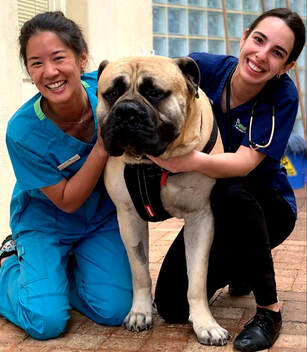
Titan is an 81kg, 2.5 year old bull mastiff cross that presented to KSAH for a castration and prophylactic gastropexy surgery.
A gastropexy is a surgical procedure performed in deep chested dogs to prevent a life-threatening condition called gastric dilatation volvulus (GDV) where the stomach rotates around itself, fills with air and cuts off blood supply to itself and other vital organs (please refer to diagram below).
Deep chested dogs are commonly large or giant breeds but GDV can also occur in small breeds. At-risk breeds include (but aren’t restricted to) Great Danes, Saint Bernards, Dalmatians, Weimaraners, Standard Poodles, Irish Setters, German Shepherds and Bull Mastiffs.
While the cause of GDV is not yet completely understood, predisposing factors include feeding your dog a single large meal per day or exercising your dog before or right after a meal. A prophylactic (preventative) gastropexy surgery attaches the stomach wall to the body wall to prevent it from twisting. It can be performed in conjunction with a desexing procedure or on its own.
A gastropexy is a surgical procedure performed in deep chested dogs to prevent a life-threatening condition called gastric dilatation volvulus (GDV) where the stomach rotates around itself, fills with air and cuts off blood supply to itself and other vital organs (please refer to diagram below).
Deep chested dogs are commonly large or giant breeds but GDV can also occur in small breeds. At-risk breeds include (but aren’t restricted to) Great Danes, Saint Bernards, Dalmatians, Weimaraners, Standard Poodles, Irish Setters, German Shepherds and Bull Mastiffs.
While the cause of GDV is not yet completely understood, predisposing factors include feeding your dog a single large meal per day or exercising your dog before or right after a meal. A prophylactic (preventative) gastropexy surgery attaches the stomach wall to the body wall to prevent it from twisting. It can be performed in conjunction with a desexing procedure or on its own.
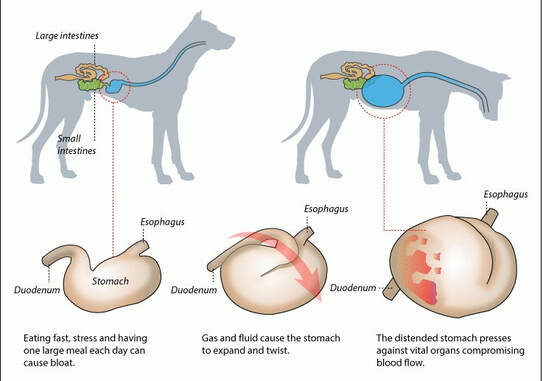
In Titan's case, Dr Hadisa performed the gastropexy during his castration surgery. Titan also had one testicle located in his scrotum and the other retained in his abdomen. It was a long procedure but Titan recovered well from it.
In the photo above, Dr Hadisa and nurse Fiona celebrated with a happy Titan after they removed his stitches. We’ll miss having him in hospital as much as he will miss our beef treats!
In the photo above, Dr Hadisa and nurse Fiona celebrated with a happy Titan after they removed his stitches. We’ll miss having him in hospital as much as he will miss our beef treats!
July 2019 "Bear" - Giant Lump
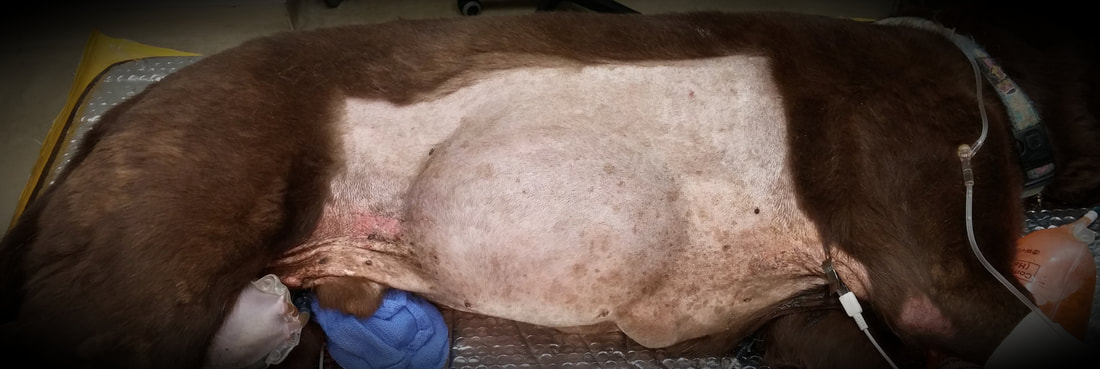
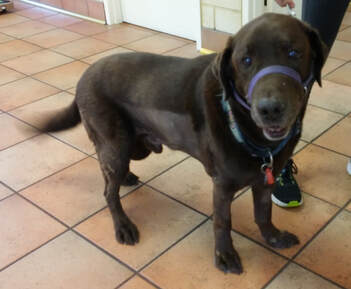
Bear is a 13 year old male Labrador that presented to KSAH with a large mass on his side.
The mass, attached to the right side of Bear’s chest and abdomen measured a whopping 27 cm and was firmly adhered to the underlying muscles. Fine needle aspirates taken of the mass revealed a mixture of fat cells, red blood cells and inflammatory cells and it was suspected that this was a very large lipoma (lump of fat).
His blood tests showed no significant abnormalities in his internal organs, meaning that he was ok to be anaesthetised for his giant lump to be surgically removed.
Prior to surgery, an ultrasound scan was conducted to assess the lump’s margins and ascertain whether it had encroached into the surrounding muscle layers. The mass appeared to be reasonably well contained and had not invaded the underlying muscular abdominal wall.
Bear was then placed on fluid therapy and prepared for surgery. Dr Cindy surgically removed the 1.75kg mass (which thankfully looked like a very large lipoma). As the mass had left behind a large cavity, an active drain had to be placed in the wound to assist with healing and drainage. Bear remained with us overnight to receive IV pain relief and wound care. He was able to go home the following day on pain relief and antibiotics.
Bear has since had his sutures removed and seems much happier and more spritely without the giant lump weighing him down!
The mass, attached to the right side of Bear’s chest and abdomen measured a whopping 27 cm and was firmly adhered to the underlying muscles. Fine needle aspirates taken of the mass revealed a mixture of fat cells, red blood cells and inflammatory cells and it was suspected that this was a very large lipoma (lump of fat).
His blood tests showed no significant abnormalities in his internal organs, meaning that he was ok to be anaesthetised for his giant lump to be surgically removed.
Prior to surgery, an ultrasound scan was conducted to assess the lump’s margins and ascertain whether it had encroached into the surrounding muscle layers. The mass appeared to be reasonably well contained and had not invaded the underlying muscular abdominal wall.
Bear was then placed on fluid therapy and prepared for surgery. Dr Cindy surgically removed the 1.75kg mass (which thankfully looked like a very large lipoma). As the mass had left behind a large cavity, an active drain had to be placed in the wound to assist with healing and drainage. Bear remained with us overnight to receive IV pain relief and wound care. He was able to go home the following day on pain relief and antibiotics.
Bear has since had his sutures removed and seems much happier and more spritely without the giant lump weighing him down!
June 2019 "Bandit" - Bladder Stone
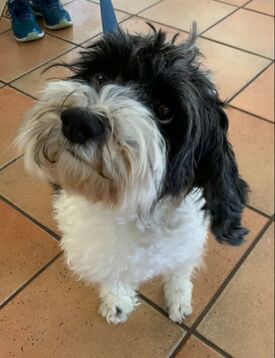
Bandit is a 5 year old female Cavoodle that presented to KSAH as she was struggling to urinate and her owners had noticed blood in her urine.
On physical exam, Dr Jess discovered that Bandit was slightly uncomfortable when her bladder was palpated but was otherwise well, and suspected that Bandit had a urinary tract infection. She performed a microscopic examination of Bandit’s urine and it contained a large amount of blood and bacteria, so she started on a course of antibiotics.
At her recheck 2 weeks later Bandit’s family reported no improvement on her medication and her urine still had blood and bacteria. Her urine was sent off for a culture to determine what kind of bacteria was causing this urinary infection, and which antibiotics would kill these nasty bugs 🧫 🦠. Strangely enough, the antibiotics she had been on for the past 2 weeks were appropriate for her infection but had not resolved her problem.
An abdominal ultrasound showed that Bandit had a large single stone in her bladder measuring 18mm x 15mm which was the cause of her ongoing infections and discomfort.
On physical exam, Dr Jess discovered that Bandit was slightly uncomfortable when her bladder was palpated but was otherwise well, and suspected that Bandit had a urinary tract infection. She performed a microscopic examination of Bandit’s urine and it contained a large amount of blood and bacteria, so she started on a course of antibiotics.
At her recheck 2 weeks later Bandit’s family reported no improvement on her medication and her urine still had blood and bacteria. Her urine was sent off for a culture to determine what kind of bacteria was causing this urinary infection, and which antibiotics would kill these nasty bugs 🧫 🦠. Strangely enough, the antibiotics she had been on for the past 2 weeks were appropriate for her infection but had not resolved her problem.
An abdominal ultrasound showed that Bandit had a large single stone in her bladder measuring 18mm x 15mm which was the cause of her ongoing infections and discomfort.
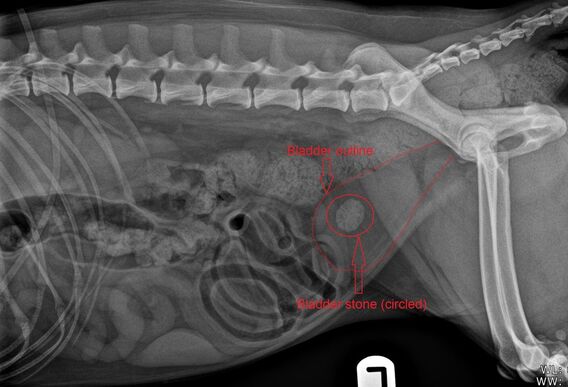
Bandit was prepared for surgery to remove the stone. Dr Hadisa initially took an X-ray of the abdomen to identify the location of the stone and it was then surgically removed from the bladder. The stone was sent to a pathology laboratory to be analysed for its contents.
It has been 1 month since her surgery and Bandit is now urinating comfortably. Her urine no longer contains blood and bacteria and she is back to her normal self. She does however have to stay permanently on a prescription diet to prevent further bladder stones from developing.
It has been 1 month since her surgery and Bandit is now urinating comfortably. Her urine no longer contains blood and bacteria and she is back to her normal self. She does however have to stay permanently on a prescription diet to prevent further bladder stones from developing.
May 2019 "Bella" - Pyometra (Infected Pus-Filled Uterus)
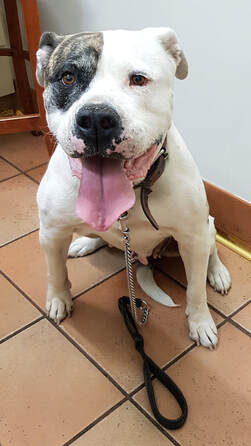
Bella is a seven and a half year old American Bulldog that presented to KSAH as she was losing weight, and drinking and urinating more. At the time of presentation Bella was an entire female and had her last heat 6 weeks prior. On physical exam she was underweight and had multiple masses adjacent and attached to her mammary tissue.
A full blood panel was conducted and showed evidence of chronic (long term) inflammation and anaemia (decrease in red blood cells). Dr Cindy suspected Bella had either cancer in her mammary chain, pyometra, or potentially both.
Pyometra is a life-threatening infection of the uterus that can affect female dogs and cats that have not been desexed. It occurs as a result of hormonal changes in the reproductive tract that cause thickening of the uterine wall in preparation for pregnancy. If no pregnancy occurs after consecutive heat cycles, the lining continues to thicken and creates an ideal environment for bacterial infection to occur.
Surgery is always indicated to remove the ovaries and infected uterus. Pyometra can be classed as “open” (pus discharge draining from the vulva) or “closed” (pus is enclosed within the uterus without visible discharge from the vulva).
Bella initially had a closed pyometra, which eventually progressed to a partially open pyometra and was draining green pus.
A full blood panel was conducted and showed evidence of chronic (long term) inflammation and anaemia (decrease in red blood cells). Dr Cindy suspected Bella had either cancer in her mammary chain, pyometra, or potentially both.
Pyometra is a life-threatening infection of the uterus that can affect female dogs and cats that have not been desexed. It occurs as a result of hormonal changes in the reproductive tract that cause thickening of the uterine wall in preparation for pregnancy. If no pregnancy occurs after consecutive heat cycles, the lining continues to thicken and creates an ideal environment for bacterial infection to occur.
Surgery is always indicated to remove the ovaries and infected uterus. Pyometra can be classed as “open” (pus discharge draining from the vulva) or “closed” (pus is enclosed within the uterus without visible discharge from the vulva).
Bella initially had a closed pyometra, which eventually progressed to a partially open pyometra and was draining green pus.
WARNING: GRAPHIC IMAGES BELOW:
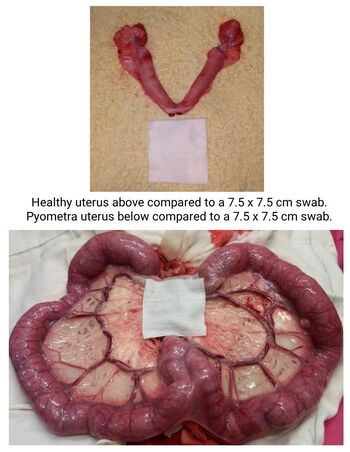
An ultrasound was conducted and a diagnosis of pyometra was confirmed. Bella was placed on aggressive fluid therapy, administered intravenous antibiotics and prepared for surgery. As her health condition was poor, general anaesthetic was very risky for her. She was closely monitored and supported by our skilled team of nurses throughout her procedure.
During surgery an extremely enlarged, inflamed and pus-filled uterus was identified and removed by Dr Cindy. In the photo on the left, the uterus weighed 1.2kg and is compared to a healthy uterus of a similar sized dog. A 7.5cm x 7.5cm gauze swab was placed next to each uterus for size comparison.
Her owner is very happy that Bella has since recovered well from her surgical procedure and is back to her bouncy normal self!
During surgery an extremely enlarged, inflamed and pus-filled uterus was identified and removed by Dr Cindy. In the photo on the left, the uterus weighed 1.2kg and is compared to a healthy uterus of a similar sized dog. A 7.5cm x 7.5cm gauze swab was placed next to each uterus for size comparison.
Her owner is very happy that Bella has since recovered well from her surgical procedure and is back to her bouncy normal self!
July 2017 "Chyna" - Luxating Patella (knee cap)
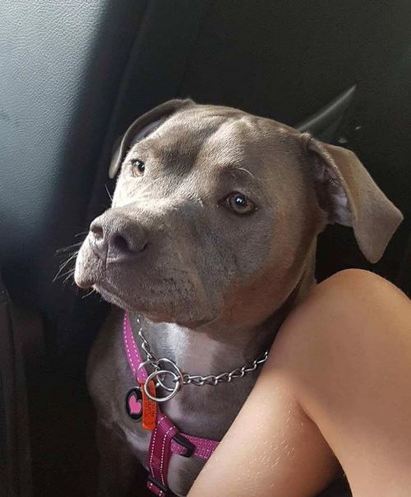
Meet Chyna, she's a gorgeous one year old blue Staffy. Recently Chyna's family brought her into Karrinyup Small Animal Hospital to see Dr. Emma because she was having intermittent lameness on her right hind limb. Dr. Emma examined Chyna and noticed that her right knee cap (patella) was dislocating (luxating) out of place.
A luxating patella occurs when the knee cap repeatedly moves out of its natural position in the groove of the lower femur. It can be quite painful when this happens and the dog will have difficulty putting weight on the leg. Some dogs may learn to kick and push the knee cap back into place, but over time the joint will become arthritic and painful if left untreated.
A luxating patella occurs when the knee cap repeatedly moves out of its natural position in the groove of the lower femur. It can be quite painful when this happens and the dog will have difficulty putting weight on the leg. Some dogs may learn to kick and push the knee cap back into place, but over time the joint will become arthritic and painful if left untreated.
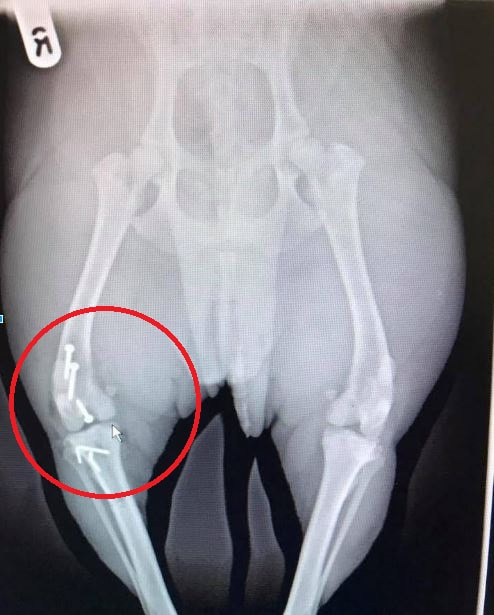
Chyna came in for x-rays to confirm the medial patella luxation and the following week came in for her surgical repair. Chyna had a “RidgeStop” prosthesis implanted by Dr Cindy. This surgery works by screwing a special implant onto the ridge of the groove where the knee cap is dislocating. It creates a barrier to stop the knee cap from popping out of place.
In Chyna's case, the attachment of the knee cap to the bone below (the tibia) was also in the wrong position. To fix this, that portion of the tibia (known as the tibial crest) is cut and reattached to the bone in a more central position so that the knee cap is realigned back in the groove. As you can see in Chyna's x-ray, there are screws holding the “RidgeStop” implant in place and pins holding the tibial crest in its new position.
In Chyna's case, the attachment of the knee cap to the bone below (the tibia) was also in the wrong position. To fix this, that portion of the tibia (known as the tibial crest) is cut and reattached to the bone in a more central position so that the knee cap is realigned back in the groove. As you can see in Chyna's x-ray, there are screws holding the “RidgeStop” implant in place and pins holding the tibial crest in its new position.
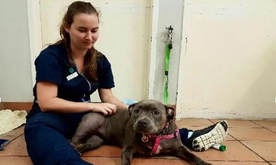
Chyna continued her recovery in hospital for a few days after her surgery. She had physio performed on her leg several times a day during her recovery, as you can see in the photo with Emma, one of our nurses.
5 weeks after her surgery Chyna came back in for her recheck x-rays, which showed that her leg had healed beautifully. We are pleased to report that Chyna is continuing to recover well from her surgery and is enjoying life at home with her loving family
Below is a testimonial Chyna's family wrote to Karrinyup Small Animal Hospital about her care here:
5 weeks after her surgery Chyna came back in for her recheck x-rays, which showed that her leg had healed beautifully. We are pleased to report that Chyna is continuing to recover well from her surgery and is enjoying life at home with her loving family
Below is a testimonial Chyna's family wrote to Karrinyup Small Animal Hospital about her care here:
“Chyna, my one year old Blue Staffordshire Terrier, was showing obvious signs of lameness and discomfort in her right rear leg. I took her to Karrinyup Small Animal Hospital as soon as possible to investigate what could cause this sudden change in Chyna.
The vet gave me her ideas on what the problem could be. A week later Chyna had x-rays that confirmed the vets thoughts. I was given the current orthopaedic treatment options available, pros and cons of each, and recommendations on what they thought was best for Chyna given her age and physical condition. I felt very comfortable with the information being presented to me and agreed to the recommended procedure.
Chyna had a four day stay at KSAH after surgery. We were given visitation times to check on her and speak to the vet about her recovery. We also received emails during the nights with pictures of Chyna keeping us updated on her progress and general well-being. It was a very nice touch seeing that she was being well looked after and not just locked up in a cage. She is such a people dog.
Even with all the attention she received during Chyna’s stay it still did take its toll on her mentally and physically. No one likes hospitals and this was her first stay away from us since she was 8 weeks old. She was very stressed from the separation. Once home it took her a couple days to return to her normal self.
Chyna’s post surgery care has been exceptional. We are being kept informed on her progress and any concerns are dealt with promptly. After a week of good progress Chyna started to favour the injured leg again. KSAH took her in for half a day for some intense physiotherapy and give me some more information to better care for the way she is healing.
Overall, I am extremely pleased with Chyna’s treatment by Dr Cindy & the team at KSAH. I highly recommend KSAH & have no hesitations continuing Chyna’s lifelong healthcare with them.
Thank you for treating our fur baby so well.”
Paul
Dawn's Unprovoked Attack
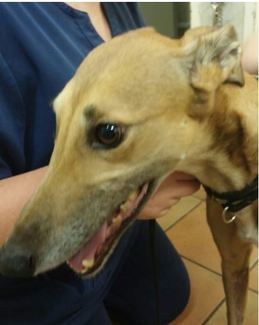
Introducing Dawn! Dawn is a beautiful natured 3 year old Greyhound who unfortunately was savagely mauled by another dog on a walk at her local park. Dawn presented to Karrinyup Small Animal Hospital with severe dog bite injuries.
Dawn was immediately started on intravenous fluids and pain relief as she was in a lot of pain. Once Dawn was stable, she was anaesthetised and taken into surgery to assess and treat her wounds.
Dawn had sustained large skin wounds and extensive damage to multiple muscle layers along her back and the sides of her chest. She also had a lot of trauma and bruising to the underside of her chest, down her forelimbs and her lower back area (Image 1).
Dr Emma Sharples cleaned and flushed her wounds before debriding (removing) the damaged tissues. Several drains were placed whilst suturing her skin and muscles closed (Image 2).
Dawn was immediately started on intravenous fluids and pain relief as she was in a lot of pain. Once Dawn was stable, she was anaesthetised and taken into surgery to assess and treat her wounds.
Dawn had sustained large skin wounds and extensive damage to multiple muscle layers along her back and the sides of her chest. She also had a lot of trauma and bruising to the underside of her chest, down her forelimbs and her lower back area (Image 1).
Dr Emma Sharples cleaned and flushed her wounds before debriding (removing) the damaged tissues. Several drains were placed whilst suturing her skin and muscles closed (Image 2).
WARNING: GRAPHIC IMAGE BELOW

Due to the extensive tissue trauma, Dawn developed dangerously high levels of Potassium in her bloodstream. When Potassium levels are too high it can interfere with the functioning of the heart and can potentially lead to cardiac arrest and death. Dawn was transferred to an Emergency 24hr Veterinary Hospital for overnight monitoring to ensure the gradual reduction of the Potassium levels. Dawn returned to Karrinyup Small Animal Hospital in the morning for continued wound management.
After a few days, although Dawn appeared to be doing well in herself, her wounds started to break down from massive infection present despite being on antibiotic therapy. Dawn was readmitted for a second surgery which involved further debridement of her necrotic (dying) muscle tissue, and a swab sample was taken of her wound to run a culture and sensitivity test.
A culture and sensitivity test is where a small sample of infected tissue or discharge is taken and grown in a laboratory to determine the type of bacteria present. The bacteria is then tested against several antibiotics to determine the most effective one we can use against it.
The result of Dawn’s culture and sensitivity test revealed a very unusual bacteria called 'Serratia marcescens', that was resistant to three different types of antibiotics.
Armed with knowledge from this test, Dawn started on a new antibiotic which remarkably improved her condition. Her wounds stopped discharging and a lot of her swelling reduced.
After three weeks and lots of intensive care by her mum at home, Dawn has now recovered from her injuries. She has lost significant amounts of muscle tissue due to the attack and only time will tell if her body regains full function. So far she is doing very well and we are happy with her progress.
Throughout the entire ordeal Dawn has been the perfect patient and very resilient despite such an extensive injury.
After a few days, although Dawn appeared to be doing well in herself, her wounds started to break down from massive infection present despite being on antibiotic therapy. Dawn was readmitted for a second surgery which involved further debridement of her necrotic (dying) muscle tissue, and a swab sample was taken of her wound to run a culture and sensitivity test.
A culture and sensitivity test is where a small sample of infected tissue or discharge is taken and grown in a laboratory to determine the type of bacteria present. The bacteria is then tested against several antibiotics to determine the most effective one we can use against it.
The result of Dawn’s culture and sensitivity test revealed a very unusual bacteria called 'Serratia marcescens', that was resistant to three different types of antibiotics.
Armed with knowledge from this test, Dawn started on a new antibiotic which remarkably improved her condition. Her wounds stopped discharging and a lot of her swelling reduced.
After three weeks and lots of intensive care by her mum at home, Dawn has now recovered from her injuries. She has lost significant amounts of muscle tissue due to the attack and only time will tell if her body regains full function. So far she is doing very well and we are happy with her progress.
Throughout the entire ordeal Dawn has been the perfect patient and very resilient despite such an extensive injury.

"You never expect when you take your dog for a walk that you will both be attacked by another dog. But just before Easter, Dawn (our rescue greyhound) and I were attacked by a large uncontrolled dog in a local park. She was badly injured and urgently needed to see a vet so Karrinyup Small Animal Hospital was our destination.
The staff were great and she was taken in immediately for surgery. Unfortunately surgery revealed even far more serious injuries. She made it through but the muscle damage was extensive and there were no guarantees as to how this would compromise her movement.
Dawn was stoic and sweet natured as always throughout the ordeal accepting all the pain with only a flinch. Despite multiple setbacks, a second operation to remove more damaged muscle, and a severe bacterial infection she has survived and is now making a steady recovery.
She can go for short walks and even attempts to trot. Being a greyhound she loved nothing more than running around the backyard, this is now beyond her but we are hopeful she will get to do this again in time.
Thanks to the care and skill of the vets and nurses at Karrinyup, Dawn will continue to have a comfortable and happy life with our family.”
-Dawn’s mum, Petah
The staff were great and she was taken in immediately for surgery. Unfortunately surgery revealed even far more serious injuries. She made it through but the muscle damage was extensive and there were no guarantees as to how this would compromise her movement.
Dawn was stoic and sweet natured as always throughout the ordeal accepting all the pain with only a flinch. Despite multiple setbacks, a second operation to remove more damaged muscle, and a severe bacterial infection she has survived and is now making a steady recovery.
She can go for short walks and even attempts to trot. Being a greyhound she loved nothing more than running around the backyard, this is now beyond her but we are hopeful she will get to do this again in time.
Thanks to the care and skill of the vets and nurses at Karrinyup, Dawn will continue to have a comfortable and happy life with our family.”
-Dawn’s mum, Petah
Peetey's Lumps

Meet Peetey. She's lovely little rabbit and is 6 years old. She is always a favourite whenever she is here and loves eating her leafy greens.
Peetey's owners noticed that she had a round, marble-sized lump under her belly. They brought her into us for a check up and for Dr. Natalie to examine the lump. Dr. Natalie noticed that the firm marble-sized lump appeared to be associated with the mammary (or breast tissue) on the right side. In Peetey's case, this was most consistent with a mammary (or breast) cancer. Dr. Natalie recommended that Peetey have a partial mastectomy to have the cancerous lump removed. Dr. Natalie also recommended that Peetey be surgically desexed at the same time. This is because mammary cancers in female rabbits are also often associated with cancers in the uterus.
Peetey was admitted for surgery at Karrinyup Small Animal Hospital the following week. She was placed on intravenous fluids and anaesthetised for her surgery. She had her ovaries and uterus removed (ovariohysterectomy), during which time Dr. Natalie could see that the left horn of her uterus did indeed have a large cancer as suspected. You can view the image of her uterus below - WARNING: GRAPHIC IMAGE.
Dr. Natalie then also performed the partial mastectomy to remove the mammary cancer also.
Domestic rabbits in Australia can have a life expectancy of 6-12 years. Unfortunately, in unsterilised female rabbits, mammary and uterine cancers are very common. They are also often associated with uterine cancers. In fact, 80% of rabbits over the age of 5 will have at least early cancerous changes in their uterus. These cancers are highly aggressive and are the biggest cause of death in unsterilised female rabbits over 5 years old.
The best was to prevent these mammary and uterine cancers is through desexing. The best age to desex a female rabbit is between 5 and 7 months of age. In male rabbits desexing can be done slightly earlier at 3 to 4 months of age. Desexing is also an effective way to help prevent hormonal aggression in rabbits.
WARNING: GRAPHIC IMAGE BELOW
Peetey's owners noticed that she had a round, marble-sized lump under her belly. They brought her into us for a check up and for Dr. Natalie to examine the lump. Dr. Natalie noticed that the firm marble-sized lump appeared to be associated with the mammary (or breast tissue) on the right side. In Peetey's case, this was most consistent with a mammary (or breast) cancer. Dr. Natalie recommended that Peetey have a partial mastectomy to have the cancerous lump removed. Dr. Natalie also recommended that Peetey be surgically desexed at the same time. This is because mammary cancers in female rabbits are also often associated with cancers in the uterus.
Peetey was admitted for surgery at Karrinyup Small Animal Hospital the following week. She was placed on intravenous fluids and anaesthetised for her surgery. She had her ovaries and uterus removed (ovariohysterectomy), during which time Dr. Natalie could see that the left horn of her uterus did indeed have a large cancer as suspected. You can view the image of her uterus below - WARNING: GRAPHIC IMAGE.
Dr. Natalie then also performed the partial mastectomy to remove the mammary cancer also.
Domestic rabbits in Australia can have a life expectancy of 6-12 years. Unfortunately, in unsterilised female rabbits, mammary and uterine cancers are very common. They are also often associated with uterine cancers. In fact, 80% of rabbits over the age of 5 will have at least early cancerous changes in their uterus. These cancers are highly aggressive and are the biggest cause of death in unsterilised female rabbits over 5 years old.
The best was to prevent these mammary and uterine cancers is through desexing. The best age to desex a female rabbit is between 5 and 7 months of age. In male rabbits desexing can be done slightly earlier at 3 to 4 months of age. Desexing is also an effective way to help prevent hormonal aggression in rabbits.
WARNING: GRAPHIC IMAGE BELOW

The photo on the right shows Peetey's uterus with 2 masses in the uterine horns.
Frankie's From Venus AND Mars

Meet Frankie! Frankie is a gorgeous little 6 month old French Bulldog puppy who is always very well behaved & happy during her visits to see us. Frankie visited the clinic for her routine Spey surgery in September but it turned out her procedure wasn’t routine at all!
During her pre anaesthetic assessment Dr Emma noticed that Frankie appeared to have an abnormal protuberance coming from her vulva. On closer inspection it was revealed that she actually had a developed penis in her vulva indicating that little Frankie was in fact a Hermaphrodite.
During her pre anaesthetic assessment Dr Emma noticed that Frankie appeared to have an abnormal protuberance coming from her vulva. On closer inspection it was revealed that she actually had a developed penis in her vulva indicating that little Frankie was in fact a Hermaphrodite.

Hermaphroditism is very rare in dogs and occurs when there is a problem in normal genital development resulting in the dog having some or all of the genitals of both sexes. It is possible for a hermaphrodite to have both ovaries and testicles, one of each or a combination of the two called an ovotestis.
Even though hermaphrodite's are normally sterile it is still recommended to still desex them to prevent the risk of ovarian, testicular or uterine disease so we proceeded with Frankie's sterilisation procedure.
Even though hermaphrodite's are normally sterile it is still recommended to still desex them to prevent the risk of ovarian, testicular or uterine disease so we proceeded with Frankie's sterilisation procedure.

Dr Emma made a midline incision to explore Frankie's abdomen to find out what internal reproductive organs she possessed as there was no way of knowing based on her external appearance .
Upon exploration of her abdomen we found that Frankie had a fully developed uterus that was connected to testicles instead of ovaries. Dr Emma performed a hysterectomy & castration which all went very well and Frankie was sutured up and recovered without issue from her surgery.
Little Frankie should hopefully lead a perfectly normal life after her surgery ,although we will need to closely monitor her external genitalia to ensure she has no ongoing issues with her extra appendage. Despite Frankie's unusual condition it does not affect in the slightest what a lovely happy little dog she is. The only question is whether little Frankie should now be referred to as Frank!
Upon exploration of her abdomen we found that Frankie had a fully developed uterus that was connected to testicles instead of ovaries. Dr Emma performed a hysterectomy & castration which all went very well and Frankie was sutured up and recovered without issue from her surgery.
Little Frankie should hopefully lead a perfectly normal life after her surgery ,although we will need to closely monitor her external genitalia to ensure she has no ongoing issues with her extra appendage. Despite Frankie's unusual condition it does not affect in the slightest what a lovely happy little dog she is. The only question is whether little Frankie should now be referred to as Frank!
Token's Fetch Disaster

Meet Token, she's an adorable 1 year old blue Staffy. Token is a very friendly girl and loves to play. She particularly loves to play with balls, so much so that she swallows them whole!
Poor Token came into Karrinyup Small Animal Hospital this month after she had swallowed another dog’s toy ball while playing at the park.
Token's owner took her to an after-hours emergency vet where they gave Token an injection to try and get her to vomit up the ball. Unfortunately, vomiting did not bring up the ball and it remained inside her.
Poor Token came into Karrinyup Small Animal Hospital this month after she had swallowed another dog’s toy ball while playing at the park.
Token's owner took her to an after-hours emergency vet where they gave Token an injection to try and get her to vomit up the ball. Unfortunately, vomiting did not bring up the ball and it remained inside her.

Token then came to Karrinyup Small Animal Hospital to see Dr Emma. Dr Emma took an abdominal x-ray of Token that showed the ball was still sitting firmly in her stomach.
Here you can see the x-ray of Token's abdomen showing the large 5cm round ball sitting within her stomach.
Due to the large size of the ball there was no way poor Token would be able to pass it out in her stools.
Here you can see the x-ray of Token's abdomen showing the large 5cm round ball sitting within her stomach.
Due to the large size of the ball there was no way poor Token would be able to pass it out in her stools.

Token was admitted straight away for surgery. Dr Emma performed the surgery and removed the ball via an incision into the stomach. Here you can see a picture of the ball after it was removed.
Token was kept in hospital for a few days to recover after her surgery until she was ready to go back home to her loving family. We are pleased to say that Token has made a full recovery and has been going great. Needless to say, every effort is being made to keep her away from toy balls in the future!
Token was kept in hospital for a few days to recover after her surgery until she was ready to go back home to her loving family. We are pleased to say that Token has made a full recovery and has been going great. Needless to say, every effort is being made to keep her away from toy balls in the future!
Lexi's Colourful Meal

Meet Lexie, she's a beautiful and much loved 5 year old Labrador. Lexie is a very friendly and playful girl who like most Labradors, loves her food. Lexie has even developed a bit of a taste for her owner's homemade playdough! Poor Lexie has needed to be admitted to Karrinyup Small Animal Hospital on two separate occasions after she helped herself to some tasty playdough.
Most homemade playdough recipes contain ingredients that dogs and cats love to eat, such as flour, cornstarch and a large quantity of salt. When ingested by an animal, this is quite toxic and can result in salt poisoning.
Symptoms of salt poisoning include:
Most homemade playdough recipes contain ingredients that dogs and cats love to eat, such as flour, cornstarch and a large quantity of salt. When ingested by an animal, this is quite toxic and can result in salt poisoning.
Symptoms of salt poisoning include:
- lethargy
- vomiting and diarrhoea
- abnormal fluid accumulation in the body
- excessive thirst and urination
- potential kidney damage
- potential neurological signs such as tremors and seizures
- potential heart problems, especially in animals with pre-existing heart issues

Unfortunately when Lexie helped herself to playdough she did it very secretly without her owner knowing about it. Lexie's owner suddenly noticed that Lexie was drinking a lot of water. She even drank half a bucket of water in one go. Lexie's owner brought her straight into Karrinyup Small Animal Hospital where Dr Cindy found that Lexie's stomach was very large and distended. Her blood work revealed that the amount of salt (sodium) in her bloodstream was very high. She then started to vomit a large amount of fluid which contained the brightly coloured playdough.
Treatment for salt poisoning involves careful intravenous fluid administration, blood electrolyte monitoring and supportive care. For Lexie, the second time she was admitted, Dr Cindy had to induce vomiting to reduce further absorption of salt from the playdough. You can see the colourful array of dough that she brought up in the photo.
If you think your dog or cat could have eaten some playdough, it's important to call your veterinarian immediately. It's also important to remember that commercially made playdoughs also contain salt, though typically at lower quantities. Even relatively small quantities of salt can cause problems in smaller pets. Additionally, a large enough mass of ingested playdough can cause a digestive foreign body obstruction.
If you think your dog or cat could have eaten some playdough, it's important to call your veterinarian immediately. It's also important to remember that commercially made playdoughs also contain salt, though typically at lower quantities. Even relatively small quantities of salt can cause problems in smaller pets. Additionally, a large enough mass of ingested playdough can cause a digestive foreign body obstruction.
Felix's Sun Kiss

This is Felix, he's a very handsome 11 year old white Domestic Short Hair cat. His owner was concerned about some scabby lumps that had been forming on the outside of his ears. Dr Cindy examined Felix and found that these lumps were skin cancers that had developed on his ears.
A common type of skin cancer is “Squamous Cell Carcinoma” or SCC. SCCs are malignant and particularly invasive tumours that can spread to other locations in the body.
SCCs of the ears and face are caused by excessive sun exposure over a long period of time. It is more common in white cats, or cats with white ears, just like Felix. They usually form on areas of sparsely haired skin such as ear tips and noses. These tumours start out as red, crusty sores and with time, they slowly get bigger and spread.
A common type of skin cancer is “Squamous Cell Carcinoma” or SCC. SCCs are malignant and particularly invasive tumours that can spread to other locations in the body.
SCCs of the ears and face are caused by excessive sun exposure over a long period of time. It is more common in white cats, or cats with white ears, just like Felix. They usually form on areas of sparsely haired skin such as ear tips and noses. These tumours start out as red, crusty sores and with time, they slowly get bigger and spread.

Treatment of SCCs depends on the number and size of cancerous lesions* present. If only one small lesion is present, it may be removed with cryosurgery (freezing). If the lesions are multiple and larger, surgical removal is needed. Felix had multiple large lesions on both of his ears. This meant that the only way to successfully remove all of the cancers was to surgically remove both of the upright parts (or pinna) of his ears. Felix also had small cancerous lesions on his nose which were removed by cryosurgery (freezing).
We are pleased to say that Felix has been doing very well after his surgery. He's able to live a perfectly normal life without his ears. He may look a little different now but we think he's just as cute as ever. He will need ongoing monitoring to make sure he doesn't develop any new sores on his face. He will also need to limit the amount of time he spends out in the sun.
Some other preventative measures that can be taken to reduce sun exposure include:
We are pleased to say that Felix has been doing very well after his surgery. He's able to live a perfectly normal life without his ears. He may look a little different now but we think he's just as cute as ever. He will need ongoing monitoring to make sure he doesn't develop any new sores on his face. He will also need to limit the amount of time he spends out in the sun.
Some other preventative measures that can be taken to reduce sun exposure include:
- Applying sunscreen to the ears, nose and areas of the body that have a thin hair coat
- Placing a shade or reflector over windows for cats that like to spend a lot of time on the window sill
*lesions are a region in an organ or tissue which has suffered damage through injury or disease, such as a wound, ulcer, abscess, or tumour.
Daisy's Bush Friends

Meet Daisy, she's a gorgeous 4 month old Border Collie Puppy. Daisy is a real sweetheart and loves her cuddles. Daisy came into Karrinyup Small Animal Hospital recently for her puppy vaccinations. Her owner suspected that she may have had a tick on her. Dr Natalie examined Daisy and found she did have several brown dog ticks on her body, the largest of which was in between her toes! Fortunately, Daisy was very brave and allowed Dr Natalie to gently remove the ticks (some of which can be seen on the swab in the photo below).
Bush ticks and brown dog ticks are commonly found in Western Australia, particularly in areas of bushland (see map below). Dogs are the most common host of the brown dog ticks. Adult ticks are flat and red-brown in colour. As the tick feeds, it engorges with blood and swells to an olive colour (as can be seen in the top right corner of the swab below). If left untreated, tick numbers will increase rapidly and very high infestations can cause anaemia due to blood loss. Ticks can also transmit blood parasites, causing further illness.
Bush ticks and brown dog ticks are commonly found in Western Australia, particularly in areas of bushland (see map below). Dogs are the most common host of the brown dog ticks. Adult ticks are flat and red-brown in colour. As the tick feeds, it engorges with blood and swells to an olive colour (as can be seen in the top right corner of the swab below). If left untreated, tick numbers will increase rapidly and very high infestations can cause anaemia due to blood loss. Ticks can also transmit blood parasites, causing further illness.

Paralysis ticks are not naturally found in Western Australia. Reported cases in Western Australia are seen in animals that have recently traveled from the eastern states (New South Wales and Queensland).
Signs of paralysis tick intoxication include weakness starting in the back legs, lack of coordination and breathing problems. It can be fatal and these signs can take up to three days to present.
Signs of paralysis tick intoxication include weakness starting in the back legs, lack of coordination and breathing problems. It can be fatal and these signs can take up to three days to present.

If you live in or visit a tick area, it's very important to use a tick control product such as NexGard Spectra or a Seresto Collar, and to check your pets for ticks daily. You can check your pet for ticks by running your hands through their coat, feeling their skin for anything unusual. Also check between the toes and inside the ears. Should you find a tick, it should be removed immediately. Tweezers can be used to grasp the tick as close to the skin as possible and pull the tick out in one firm, steady motion.
After Daisy had her ticks removed, she was given a spot on treatment to kill any remaining smaller ticks (they can be very hard find in that fluffy long coat of hers).
After Daisy had her ticks removed, she was given a spot on treatment to kill any remaining smaller ticks (they can be very hard find in that fluffy long coat of hers).
Tom's Sewing Together His 9 Lives
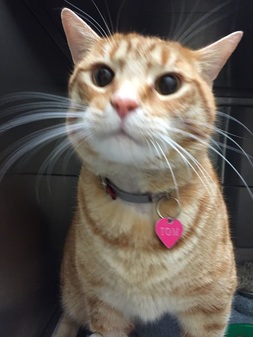
Meet Tom, he's a mischievous three year old cat who got into a spot of bother last month when he managed to swallow something very worrisome! Tom's owner brought him into Karrinyup Small Animal Hospital after they noticed that he had eaten a long piece of thread. Since then he had vomited and was gagging repeatedly. He was also very lethargic and was off his food.
Tom was admitted into hospital and x-rays showed he had a large, long metal object lodged in his throat. The foreign body identified was a sewing needle and can be clearly seen in the x-ray below.
Tom was admitted into hospital and x-rays showed he had a large, long metal object lodged in his throat. The foreign body identified was a sewing needle and can be clearly seen in the x-ray below.

While Tom was under general anaesthetic, Dr. Ruth was able to pass an endoscope down into his throat to find the needle in question. Using long forceps, the needle (which also had some thread still attached) was removed from poor Tom's throat.
Tom stayed in hospital for a few days on antibiotics, anti-inflammatories and pain relief. Within a few days he was back to normal at home and back to his old tricks again (but staying away from needles and thread!)
Tom was very lucky that the needle did not cause more extensive damage to his throat, oesophagous and trachea. Thread and other string-like objects can also be very dangerous for cats, causing what is known as a “linear foreign body”. These lodge in the intestines and cause it to bunch up and cause extensive intestinal damage requiring emergency surgery. It's best to keep objects like these well away from cats that may want to play with and ingest them.
Tom stayed in hospital for a few days on antibiotics, anti-inflammatories and pain relief. Within a few days he was back to normal at home and back to his old tricks again (but staying away from needles and thread!)
Tom was very lucky that the needle did not cause more extensive damage to his throat, oesophagous and trachea. Thread and other string-like objects can also be very dangerous for cats, causing what is known as a “linear foreign body”. These lodge in the intestines and cause it to bunch up and cause extensive intestinal damage requiring emergency surgery. It's best to keep objects like these well away from cats that may want to play with and ingest them.
Vali's Sandy Lunch
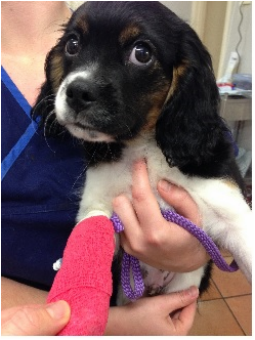
Meet Vali, he's an adorable 3 month old “Bugalier”. Vali is full of energy and loves his food. So much so that he got up to a bit of mischief one night when he ate some leftovers that had been buried in the garden! Vali happily helped himself to some leftover Dhal (containing lentils, onion and garlic) and in the process also ate a large amount of sand that it was buried in.
Poor Vali was not feeling very well. He was off his food and had vomited numerous times throughout the night. Vali's owner brought him straight to Karrinyup Small Animal Hospital that morning. The vet examined Vali, and could see that he was not his usual bright and energetic self. He was very nauseated and lethargic. The vet held a stethoscope to his abdomen and could hear a lot sand moving around in his gastrointestinal tract! A lot of sand could also be palpated on rectal examination.
Vali was admitted to hospital for blood work and abdominal x-rays. His blood work showed some electrolyte changes secondary to his vomiting and his x-rays revealed there was indeed a large amount of sand throughout his large intestine (as visible in the x-ray below). Vali was started on intravenous fluid therapy to help hydrate him and flush out the sand from his large intestine.
Poor Vali was not feeling very well. He was off his food and had vomited numerous times throughout the night. Vali's owner brought him straight to Karrinyup Small Animal Hospital that morning. The vet examined Vali, and could see that he was not his usual bright and energetic self. He was very nauseated and lethargic. The vet held a stethoscope to his abdomen and could hear a lot sand moving around in his gastrointestinal tract! A lot of sand could also be palpated on rectal examination.
Vali was admitted to hospital for blood work and abdominal x-rays. His blood work showed some electrolyte changes secondary to his vomiting and his x-rays revealed there was indeed a large amount of sand throughout his large intestine (as visible in the x-ray below). Vali was started on intravenous fluid therapy to help hydrate him and flush out the sand from his large intestine.
Because the dhal Vali had ingested along with the sand contained onion and garlic, Vali had to be monitored closely for any signs of anaemia. Onions and garlic are toxic to dogs and can cause a condition called haemolytic anaemia. This is because they contain an ingredient called “thiosulphate” which damages the red blood cells circulating through the body.
That night and the following morning Vali managed to pass a lot of sand out in his stool. Another x-ray was taken to make sure that all the sand had passed through. Once all the sand had passed through, Vali was feeling much happier in himself and started to eat his food eagerly once again.
It's important to remember that dogs will often try and eat any food scraps they may find in the garden, even when buried. Ingesting a large amount of sand with the food scraps makes for a troublesome combination!
That night and the following morning Vali managed to pass a lot of sand out in his stool. Another x-ray was taken to make sure that all the sand had passed through. Once all the sand had passed through, Vali was feeling much happier in himself and started to eat his food eagerly once again.
It's important to remember that dogs will often try and eat any food scraps they may find in the garden, even when buried. Ingesting a large amount of sand with the food scraps makes for a troublesome combination!
Alfie and His Unwanted Passengers

This is adorable Alfie. He's a one year old Border Collie x Staffy. Young Alfie was found
as a stray by the City of Stirling Rangers and was brought into Karrinyup Small Animal Hospital for veterinary assessment.
Poor Alfie was in a very sorry state when he was brought into us. He had a nasty skin infection and a lot fur loss around his face, under his neck and all over his body. He was very itchy and sore. A skin scrape revealed that Alfie had a skin mite known as “Demodex”.
as a stray by the City of Stirling Rangers and was brought into Karrinyup Small Animal Hospital for veterinary assessment.
Poor Alfie was in a very sorry state when he was brought into us. He had a nasty skin infection and a lot fur loss around his face, under his neck and all over his body. He was very itchy and sore. A skin scrape revealed that Alfie had a skin mite known as “Demodex”.

Demodex mites are microscopic and live deep in the hair follicles of the skin. They are not transmissible to other animals or humans. In low numbers, Demodex can be a normal inhabitant of dog skin. In some cases, however, these mites can take over and lead to a condition known as “Demodecosis”. This can happen quite commonly in puppies and young dogs less than 2 years of age. It is usually due to their growing/immature immune system allowing the mite to proliferate.
Despite being very sore, Alfie had the most beautiful nature in hospital. He was very brave when having his skin sores cleaned and treated. Alfie was started on antibiotics and anti-inflammatories to treat his skin infection. He was also started on an anti-parasitic medication to treat the Demodex mite.
Despite being very sore, Alfie had the most beautiful nature in hospital. He was very brave when having his skin sores cleaned and treated. Alfie was started on antibiotics and anti-inflammatories to treat his skin infection. He was also started on an anti-parasitic medication to treat the Demodex mite.

Alfie's loving and trusting nature won over the hearts of all of the vets and nurses at Karrinyup Small Animal Hospital. So much so, that one of our nurses decided to adopt Alfie and give him the loving forever home he deserves.
We are pleased to say that Alfie's skin is improving dramatically each and every day with treatment. His skin sores have all healed up and his fur has started to grow back again. Alfie is loving his new home and especially loves playing with his squeaky toys and having snuggles on the couch.
We are pleased to say that Alfie's skin is improving dramatically each and every day with treatment. His skin sores have all healed up and his fur has started to grow back again. Alfie is loving his new home and especially loves playing with his squeaky toys and having snuggles on the couch.
Lucy's Large Bladder Stones

Meet Lucy, she's an adorable 7 year old Bichon Frise. She lives at home with her brother Lewis.
Lucy's owners noticed that Lucy had been urinating more frequently and would occasionally have some blood in her urine. They also noticed that poor Lucy would sometimes seem uncomfortable and strain when urinating.
Lucy's owners noticed that Lucy had been urinating more frequently and would occasionally have some blood in her urine. They also noticed that poor Lucy would sometimes seem uncomfortable and strain when urinating.

Lucy's owners brought her into Karrinyup Small Animal Hospital where x-rays were performed and revealed that Lucy had two large stones sitting in her bladder. These are circled in the x-ray of Lucy's abdomen below. Bladder stones (also sometimes referred to as “uroliths” or “calculi”) are rock-like collections of minerals that form in the urinary bladder. These stones irritate and damage the lining of the bladder, resulting in blood in the urine. They also cause inflammation of the bladder wall, often resulting in pain and discomfort during urination.

There are multiple factors that can result in the formation of these bladder stones. They may form in dogs and cats of any age and in dogs are usually associated with a urinary tract infection. Bladder stones can develop over a period of weeks to months to even years.
Lucy had a surgery at Karrinyup Small Animal Hospital to remove the two large bladder stones. The procedure is referred to as a “cystotomy” and involves surgically opening the bladder through an abdominal incision to retrieve the bladder stones. Lucy was kept in hospital for a few days after surgery to recover and given antibiotics to treat the infection.
Lucy was a lovely little patient in hospital and we are pleased to say that she has been going well at home since her surgery. She's now on a special diet to prevent any bladder stones from re-developing in the future.
Lucy had a surgery at Karrinyup Small Animal Hospital to remove the two large bladder stones. The procedure is referred to as a “cystotomy” and involves surgically opening the bladder through an abdominal incision to retrieve the bladder stones. Lucy was kept in hospital for a few days after surgery to recover and given antibiotics to treat the infection.
Lucy was a lovely little patient in hospital and we are pleased to say that she has been going well at home since her surgery. She's now on a special diet to prevent any bladder stones from re-developing in the future.
Penelope's Rough Start

Penelope is a gorgeous (and sometimes mischievous) little kitten. Her owners adopted Penelope when she was 2 months old and at home she's a little bundle of energy.
One night when Penelope was just 5 months old, her owners came home and found she was limping badly on her right back leg. They brought her into Karrinyup Small Animal Hospital to be examined.
One night when Penelope was just 5 months old, her owners came home and found she was limping badly on her right back leg. They brought her into Karrinyup Small Animal Hospital to be examined.

When the vet examined Penelope, she wasn't putting any weight on her right back leg at all and appeared to be very painful around her right hip joint. Penelope was admitted into hospital for x-rays to be taken under a general anaesthetic. X-rays revealed that Penelope had sustained a nasty fracture to her hip, most likely the result of a trauma, such as a fall.
The hip joint is comprised of a “ball and socket”. The “ball” part of the joint is known as the femoral head, which attaches to the femur by the femoral neck. The “socket” part of the joint is known as the acetabulum of the pelvis and this is where femoral head sits to form the joint.
The hip joint is comprised of a “ball and socket”. The “ball” part of the joint is known as the femoral head, which attaches to the femur by the femoral neck. The “socket” part of the joint is known as the acetabulum of the pelvis and this is where femoral head sits to form the joint.

As pictured in the first x-ray, Penelope's femoral head had been completely severed from the femoral neck. Penelope was more susceptible to sustaining a fracture like this because she was still a growing kitten. This means her bones were softer and therefore more prone to breaking.

Penelope had a surgery known as a “Femoral Head and Neck Osteotomy” performed. As pictured in the second x-ray, this involves removing the fractured femoral head as well as the neck of the femur. With time, the joint heals and develops its own fibrous tissue to stabilise the joint. A few days after surgery, Penelope was able to go home again.
Her family were very pleased to have her home where she could continue her recovery.
Her family were very pleased to have her home where she could continue her recovery.
|
Unit 5/207 Balcatta Road BALCATTA WA 6021
Phone: (08) 9447 4644 |




